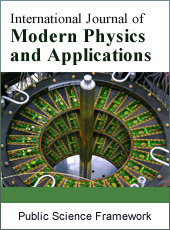International Journal of Modern Physics and Applications
Articles Information
International Journal of Modern Physics and Applications, Vol.1, No.5, Nov. 2015, Pub. Date: Dec. 20, 2015
The Medium for Motion: A Critical Clue to Understand Spacetime
Pages: 210-218 Views: 2995 Downloads: 963
[01]
Alfonso Leon Guillen Gomez, Independent Scholar, Bogota, Colombia.
Spacetime and motion are interconnected concepts. A better understanding of motion leads to a better understanding of spacetime. We use the historical critical analysis of the various theoretic proposals on motion in search of clues ignored. The prediction of the general relativity that the motion occurs in the static gravitational field is not valid because the motion always occurs in a given medium as vacuum, atmosphere, water, etc. The concept of motion and the equations of the special and general relativity, as the theory of Galilee-Newton reduce motion elements to particle and spacetime. In this paper, we present the medium (in special, the quantum vacuum), as the third essential element of motion, inseparable of spacetime since it is its material support of which the spacetime is its structural form, and we analyse its consequences in the theories of spacetime. Our contribution is declare, that the spacetime itself does not exist, or is a relational property of matter, but a structural property of matter.
Motion, Medium, Spacetime
[01]
Huggett, N and Hoefer, C. (2009). Absolute and Relational Theories of Space and Motion: The Stanford Encyclopedia of Philosophy, Zalta, E. (ed.).
[02]
Gupta, P.D. (2012). General Relativity and the Accelerated Expansion of the Universe: Springer, Volume 17, Issue 3, pp. 254-273.
[03]
Guillen, A. L. (2010a). Spacetime structural property of the matter in movement: Relativity, gravity and geometry. Petrov, Kazan, Contributed papers, 101-109.
[04]
Einstein, A. (1986). El significado de la relatividad: Planeta Colombia Editorial, S. A.
[05]
Wikipedia. (2014a). Equations of motion.
[06]
Wikipedia. (2014b). Special relativity.
[07]
Einstein, A and Infeld L. (1938). The Evolution of Physics: The Growth of Ideas from Early Concepts to Relativity and Quanta: Osmania University.
[08]
Einstein, A. (1918). Dialog about Objections against the Theory of Relativity: wikisource.
[09]
Einstein, A. (1920). Aether and the Theory of Relativity: University of Leyden, Germany.
[10]
Einstein, A. (1954). Relativity and the Problem of Space: Relativitybook.com.
[11]
Einstein, A. (1949). Autobiographical Notes: La Salle.
[12]
Marquardt, N. (1999). Introduction to the principles of vacuum physics: CERN-99-05.
[13]
Rafelski, J and Muller, B. (1985). The structured vacuum: Deutsch Publisher.
[14]
DeWitt, B. (1967). Quantum theory of gravity. I. The canonical theory: Phys. Rev. 160, 1113–1148.
[15]
Davis, E, Teofilo, V, Haisch, B, Puthoff, H, Nickisch, L, Rueda, A and Cole, D. (2006). Review of Experimental Concepts for Studying the Quantum Vacuum Field: Space Technology and Applications International Forum.
[16]
Oldershaw, R. (2009). Towards A Resolution Of The Vacuum Energy Density Crisis: arxiv.org.
[17]
Einstein, A. (1917b). Cosmological considerations in the general theory of relativity.
[18]
Rugh, S. E and Zinkernagely, H. (2000). The Quantum Vacuum and the Cosmological Constant Problem: arXiv.
[19]
Wang, S. (2007). On the super-fluid property of the relativistic physical vacuum medium and the inertial motion of particles: arXiv.
[20]
Besse, Arthur L. (1987). Einstein Manifolds. Classics in Mathematics. Berlin: Springer.
[21]
Mukhanov, V. (2015). Quantum Universe. Roma: MG14 conference.
[22]
Guillen, A. L. (2010b). Spacetime geometric structural property of the matter in motion: Relativity, gravity and geometry. Petrov, Kazan, slides.
[23]
Nandi K. K, Zhang Yuan-Zhong, Alsing P.M, Evans J.C, and Bhadra A. (2002). Analog of the Fizeau Effect in an Effective Optical Medium: arXiv: gr-qc/0208035v1.
[24]
Glass, O and Sueur, F. (2011). The movement of a solid in an incompressible perfect as a geodesic: arxiv.org.
[25]
Hawking, S. (2001). A Brief History of Time: http://www.fisica.net/relatividade/stephen_hawking_a_brief_history_of_time.pdf.

ISSN Print: 2381-6945
ISSN Online: 2381-6953
Current Issue:
Vol. 7, Issue 1, March Submit a Manuscript Join Editorial Board Join Reviewer Team
ISSN Online: 2381-6953
Current Issue:
Vol. 7, Issue 1, March Submit a Manuscript Join Editorial Board Join Reviewer Team
| About This Journal |
| All Issues |
| Open Access |
| Indexing |
| Payment Information |
| Author Guidelines |
| Review Process |
| Publication Ethics |
| Editorial Board |
| Peer Reviewers |


